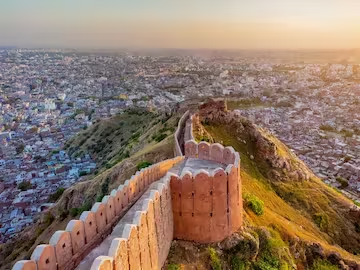
India’s ancient towns of Jaipur and Ahmedabad have merited inclusion on the esteemed UNESCO World Heritage List. The cities’ architectural wonders and rich historical importance make them magnificent representations of the nation’s rich cultural legacy. Every city reflects India’s history via its own architectural designs, historical significance, and vibrant metropolitan skyline.
Jaipur contains famous structures like the Hawa Mahal, City Palace, and Jantar Mantar, while Ahmedabad offers well-preserved historical sites including the famous Jama Masjid, Sidi Saiyed Mosque, and the busy Pol districts that showcase the city’s unique cultural tapestry. Let’s examine these cities’ histories in more detail.
Ahmedabad’s Historic City
On the eastern bank of the Sabarmati River, Sultan Ahmad Shah established the walled city of Ahmedabad in 1411 AD, making it one of Gujarat’s largest towns. For six hundred years, it flourished as the state capital. The Bhadra fortress, the Fort city’s walls and gates, many mosques and tombs, and significant Hindu and Jain temples from later eras are just a few examples of the city’s rich architectural legacy that dates back to the Sultanate era. Densely populated traditional homes (pols) on gated traditional streets with amenities like bird feeders, public wells, and places of worship make up the urban fabric.
The way the city is laid up reflects not just its amazing architectural design throughout the years but also its social fabric as a place where people live together. Because of its distinctive urban design and extensive historical history, Ahmadabad was named a UNESCO World Heritage Site in 2017. The city’s well-preserved historic structures earned it the well-earned designation as a cultural center.
There are 2,696 significant structures in Ahmedabad that are safeguarded by the Ahmedabad Municipal Corporation’s (AMC) Heritage Department, 28 monuments that are recognized by the Archaeological Survey of India (ASI), and one monument that is listed by the State Department of Archaeology (SDA).
Rajasthan’s Jaipur City
Located in the northwest state of Rajasthan, this area is often referred to as the Pink City. Sawai Jai Singh II established it in 1727. The walled city of Jaipur is a masterpiece situated on the plain and constructed on a grid design inspired by Vedic architecture, in contrast to other towns in the area that are situated in mountainous terrain. Large public squares known as “chaupars” are created by the continuous colonnaded establishments that line the wide roadways and converge in the middle.The façades of the temples, stores, apartments, and markets that line the major streets are all the same.The city’s urban design reflects a synthesis of Western and early Mughal and Hindu cultural concepts.
The city, which was intended to be a commercial center, has managed to hold onto its regional cooperative, artisanal, and commercial customs. This is a real-life illustration of India’s diverse cultural heritage. Jaipur was designated a UNESCO World Heritage Site in 2019. Additionally, this city’s Jantar Mantar, an astronomical observatory from the 18th century that has many tools for determining time and places in the sky, is recognized as a UNESCO World Heritage Site.
Both Ahmedabad and Jaipur are must-visit locations for tourists looking for a genuine Indian experience since they provide a distinctive fusion of culture, history, and architectural marvels. The cities are brilliant illustrations of how centuries of art, history, and custom have weaved India’s fabric.